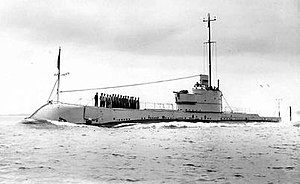HMS Otus (N92)
 HMS Otus
| |
| History | |
|---|---|
| Name | HMS Otus |
| Ordered | 2 December 1926 |
| Builder | Vickers-Armstrongs (Barrow-in-Furness, U.K.) |
| Laid down | 31 May 1927 |
| Launched | 31 August 1928 |
| Commissioned | 5 July 1929 |
| Decommissioned | March 1946 |
| Identification | Pennant number N92 |
| Fate | Scuttled near Durban, South Africa in 1946 |
| General characteristics | |
| Class and type | Template:Sclass- submarine |
| Displacement |
|
| Length | 283 ft 6 in (86.41 m) |
| Beam | 30 ft (9.1 m) |
| Draught | 16 ft 1 in (4.90 m) |
| Propulsion |
|
| Speed |
|
| Range | |
| Test depth | 300 ft (91 m) |
| Complement | 53-55 officers and men |
| Armament |
|
HMS Otus was an O-class submarine of the Royal Navy. She was laid down by Vickers-Armstrongs of Barrow-in-Furness on 31 May 1927, launched on 31 August 1928[1] and commissioned on 5 July 1929.
Service history
Otus was first commissioned for service with the 4th Submarine Flotilla on the China Station, and when the war broke out in 1939 she was deployed with the 1st Submarine Flotilla based at Alexandria with the Mediterranean Fleet. From July to December 1941 the submarine was based at Malta from where she carried out interception patrols with the 1st Flotilla.[1]
During 1941 she carried out patrols off Azores in defence of HG convoys on passage to and from Gibraltar, and with Olympus for patrol of Oran to intercept Vichy Dunkerque reported to about to attempt passage to France during Operation Principal.
On 14 August 1941 she was involved in a friendly fire incident, when the submarine Talisman under the command of Lt.Cdr. M. Willmott, RN mistook her for an enemy submarine and fired several to torpedoes at her, approximately 140 nautical miles (260 km; 160 mi) north-west of Alexandria (position 32°41'N, 27°35'E).[2]
On 3 September 1941, under command of Lt. R.M. Favell, RN, Otus unsuccessfully fired a torpedo at an unidentified enemy armed merchant cruiser of 4000 tons, approximately 175 nautical miles (324 km; 201 mi) east of Valletta, Malta.[2]
During 1943 she was transferred to Simonstown, South Africa for purposes of anti-submarine training.[1]
During December 1944 she was nominated to be withdrawn from service. She was paid-off and transferred to Reserve status. During 1945 she was transferred to Durban, South Africa. Otus was scuttled off Durban in September 1946.
Discovery of the wreck
The wreck was rediscovered during March 2013 by two deep sea specialist divers, Patrick Voorma and Allan Maclean, from the Calypso Dive Centre at uShaka Marine World, Durban approximately 8 kilometres (4.3 nmi) south-east of the Durban Harbour entrance, at an approximate depth of 100 m (330 ft).[3]
References
- ^ a b c "HMS OTUS (N.92) - O-class Submarine". naval-history.net. Retrieved 18 April 2015.
- ^ a b "HMS Otus (N92)". u-boat.net. Retrieved 18 April 2015.
- ^ Calypso Dive Centre, uShaka Marine World Archived 17 September 2013 at the Wayback Machine
29°52′21″S 31°05′39″E / 29.87250°S 31.09417°E
External links
- U-Boat.Net. HMS Otus (N 92). Retrieved 27 September 2013.
- Naval History. HMS OTUS (N.92) - O-class Submarine. Retrieved 27 September 2013.
- Submariners Association: O Class
- Naval History
- U-Boat.Net
